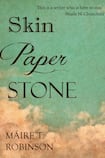
Intelligence, good looks and a sharp sense of humour doesn’t stop Stevie, the narrator of Máire T Robinson’s debut novel from feeling uncomfortable in her own skin. On the cusp of her thirties, most of Stevie’s friends are getting married and having babies. She visits the new-borns, brings presents, knows the right things to say. Underneath she feels like a fraud: “Stevie had everyone fooled. Everyone apart from the babies.”
Skin, Paper, Stone is a deceptively simple novel that packs a punch. Robinson writes with warmth and understanding, giving the reader a bird's-eye view of a modern, post-boom Galway through a diverse and credible cast of characters.
Kavanagh is an affable young man whose plans to be an artist have been sidelined. Now he sells weed and dreams of escaping to Thailand. The skin trope links himself and Stevie, each of them mistreating their bodies. Learning to be a tattoo artist, Kavanagh practises on himself: “His body was not a temple, it seemed, but something to scratch and claw at.”
Other engaging characters include Kavanagh’s mother, given a new lease of life after her strait-laced husband dies; stoner Alex, with his love of home-grown plants and art-house movies; the malevolent presence of Pajo the dealer, and his much maligned bit-on-the-side Jacqui.
The main story belongs to Stevie, who leaves her hometown of Dublin for a PhD in the west after breaking up with her long-term boyfriend Donal. As she throws herself into her work, the reader has little sense of the turmoil she is hiding.
An unusually summery Galway greets her on arrival, a “Celtic Shangri-La”. Robinson showcases the city to great effect, from Eyre Square, to the university campus, to the vibrant pub culture. In her initial weeks, Stevie embraces the party scene with her friend Orlaith. The author offers an authentic voice on the drug-fuelled mania: “Their words flowed out of their mouths, rolling and scattering like marbles. ‘I love you too,’ said Stevie. ‘I love this song,’ said Orlaith. ‘I love it too,’ said Stevie.” At a party, Stevie meets Kavanagh, who smashes a wine bottle to impress her and ends up in hospital. Such is the nature of the modern Irish love story.
Robinson has a Masters in creative writing from NUI Galway. Nominated for a Hennessy Literary Award in 2012, she won the Doire Press International Fiction competition the following year, which included a publishing deal for her collection of short stories, Your Mixtape Unravels My Heart.
Another Galway-affiliated writer comes to mind when reading her work. As with Nuala Ní Chonchúir's most recent novel The Closet of Savage Mementoes, Skin gives a convincing version of modern Ireland through the eyes of an insightful woman narrator. The cities of Galway and Dublin come alive in these books. The respective protagonists, Stevie and Lillis, are fully fleshed out, realistic representatives of modern Irish women. Likeable and honest, they share secrets with the reader that they are afraid of sharing with other characters. Themes of motherhood, creativity and past pains are common to both books. Romantic relationships ring true and sex scenes are well handled.
The theme of fertility looms large in Skin, with Stevie's PhD in medieval architecture providing an unusual backdrop from which to dissect the subject. As she researches sheela-na-gigs, 12th century architectural grotesques depicting naked women with exaggerated genitals, Stevie questions the role of women in societies down through the ages. Positioned over doors and windows to ward off evil, sheela-na-gigs are symbols of pre-Christian fertility. Scholars disagree over their meaning, with some believing that they depict women's lust as hideous and sinful.
The female form as repulsive is reflected in Stevie’s personal narrative. Although her new relationship with Kavanagh is going well, old demons about her body image resurface. Her history with anorexia is revealed in a quiet manner that is deeply affective.
Going home to Dublin for Christmas unsettles Stevie. The gap between how she lives and how her traditionally-minded parents would like her to live is widening. She meets up with Donal to escape the claustrophobic atmosphere and realises that he has moved on, a passing reference to a new girlfriend and a trip to Paris taking the wind out of Stevie’s sails.
Returning to Galway after the holidays, with deadlines in college approaching, Stevie finds she cannot eat at all: “She didn’t even want to hold the slice as she imagined the pores of her skin absorbing the calories from the oil.” As the problems mount for Stevie and Kavanagh, the pair must find a new way to exist, whether together or apart. Pajo and his hyena-like crew are the source of external tension as the story progresses, but it is the internal struggles that really matter. For both Stevie and Kavanagh, shedding their younger skins is easier said than done.












